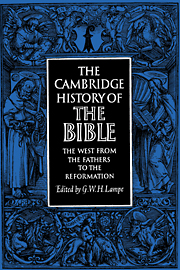Book contents
- Frontmatter
- I The Old Testament: Manuscripts, Text and Versions
- II The History of the Text and Canon of the New Testament to Jerome
- III Early Christian Book-Production: Papyri and Manuscripts
- IV Jerome
- V The Medieval History of the Latin Vulgate
- VI The Exposition and Exegesis of Scripture
- VII The ‘People's Bible’: Artists and Commentators
- VIII Bible Illustration in Medieval Manuscripts
- IX The Vernacular Scriptures
- X Erasmus in Relation to the Medieval Biblical Tradition
- Bibliography
- Notes on the Plates
- Index
- References
VIII - Bible Illustration in Medieval Manuscripts
Published online by Cambridge University Press: 28 March 2008
- Frontmatter
- I The Old Testament: Manuscripts, Text and Versions
- II The History of the Text and Canon of the New Testament to Jerome
- III Early Christian Book-Production: Papyri and Manuscripts
- IV Jerome
- V The Medieval History of the Latin Vulgate
- VI The Exposition and Exegesis of Scripture
- VII The ‘People's Bible’: Artists and Commentators
- VIII Bible Illustration in Medieval Manuscripts
- IX The Vernacular Scriptures
- X Erasmus in Relation to the Medieval Biblical Tradition
- Bibliography
- Notes on the Plates
- Index
- References
Summary
Biblical illustration in the middle ages is a vast subject whose study is still very much in its infancy. It is, therefore, impossible to give more than a brief sketch of the variety of forms which it takes. By now it is clear that illustrations of the books of the Bible were already in use by the fourth century of our era and that certain Jewish communities also had access to representations of biblical subjects. This is indicated by the paintings in the synagogue at Doura Europos which date from the middle of the third century and have scenes from the stories of Moses, Elijah, Esther and the vision of Ezekiel. The Moses series at Doura suggests that these may occasionally have been fairly complete cycles. It is difficult to be certain whether the Jewish communities of this period possessed bible picture-books. Naturally the scrolls of the Law bore no decoration, and early illustrated Jewish books have not survived. Christians seem to have been less reluctant to illustrate their bibles, though the earliest examples are by no means lavish in their provision of pictures.
In this chapter an attempt will be made to indicate something of the various methods of providing bible pictures in manuscripts between about 600 and about 1450. If the material were to be confined to the Bible as a composite work this would produce an extremely incomplete picture, since some of the fullest series of illustrations are to be found in volumes devoted to a single book or a group of books such as the book of Genesis, the Pentateuch or the four Gospels.
- Type
- Chapter
- Information
- The Cambridge History of the Bible , pp. 309 - 337Publisher: Cambridge University PressPrint publication year: 1969

